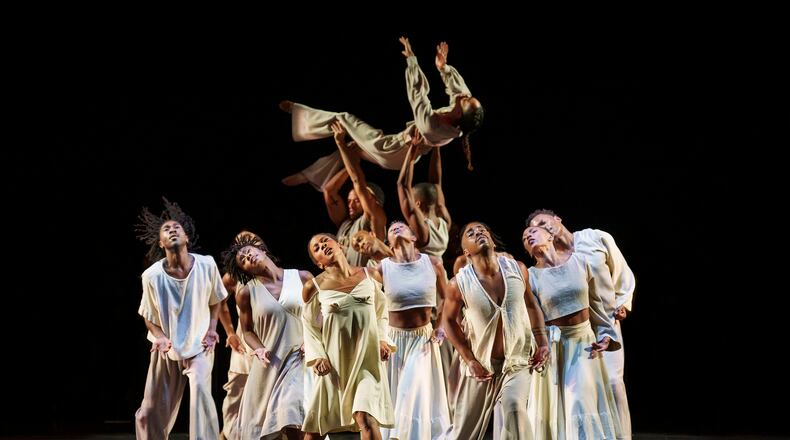Growing up in Albany, DuBois A’Keen developed a complicated relationship with his hometown.
It is the city that produced Ray Charles and provided the template for the Civil Rights Movement, but it was also segregated, impoverished and confining for a Black boy with creative leanings.
A’Keen couldn’t wait to flee to the big city.
“I felt those tensions, but those tensions very much invited who I am as an artist even today,” said A’Keen, a singer and composer.
When we talked by phone, A’Keen described a journey that eventually led him, in no particular order, to New York City, an interest in dance and a life-altering performance of “Revelations” by the Alvin Ailey American Dance Theater.
“‘Revelations’ is the dance of all dances,” A’Keen said. “It is the Leonardo da Vinci.”
The origin story of “Revelations,” the signature work of the late American choreographer Ailey, is one I thought I knew well.
Ailey was 29 when he created the piece drawing on spirituals and gospel music of his youth and the rituals of preachers and church congregations to express the joy, passion and pain of the African American experience.
“I am a Black man whose roots are in the sun and the dirt of the South,” said Ailey in an archival clip. “My best works are personal. The ones that endure seem to be the ones that have come out of my gut.”
But the version of “Revelations” that audiences have seen for more than six decades, which propelled A’Keen and so many other young people into the performing arts, is not the “Revelations” Ailey initially envisioned.
At the premiere on Jan. 31, 1960, at 92nd Street YM/YWHA in New York City, the piece had twice as many songs and the performance lasted more than an hour. Audiences would see this version only a few times before Ailey trimmed the score and scenes to prepare the performance for touring in Asia and Australia. The shortened version is the one most Ailey fans know and love.
This year, for the 65th anniversary of “Revelations,” Matthew Rushing, a former company dancer for Ailey and the current interim artistic director retrieved those lost songs, determined to mine them for information and remix them in a tribute to Ailey’s career-defining dance.
Rushing made a playlist of the nine deleted songs and called A’Keen to serve as composer. The collaboration connected Ailey, Rushing and A’Keen across three generations, each relying on their version of what Ailey called “blood memories” — memories of spirituals, faith and sadness of his youth.
“Sacred Songs” debuts in Atlanta on Feb. 14 when the company makes its annual pilgrimage to the city from Feb. 12-16 at the Fox Theatre. There is also a live album featuring tracks that didn’t make it into the dance, A’Keen said.
Using a storyboard with index cards to map out different takes, Rushing and A’Keen mixed and matched until they developed the sounds and choreography for the 40-minute performance.
“I wanted to explore the multiplicity of Black music: rock ‘n’ roll, hip-hop, funk, jazz, contemporary Christian, traditional gospel, scatting, calypso,” said A’Keen, whose dance training helped him connect the dots between music and movement.
Rushing choreographed as he listened to the music, sometimes suggesting a tempo change or different language as they worked. “We talked about narrative and which songs we would leave untouched,” Rushing said.
It was heavy work and Rushing told me he needed a way to stay grounded and present during the process.
“Studying the spirituals kept me focused through the moments of feeling like it was a big responsibility to take on,” he said. “I didn’t want anyone to think I was trying to make another ‘Revelations.’”
Rushing and A’Keen said they did a lot of improvisation but they both came to “Pilgrim’s Song” from “Revelations” with a measure of certainty about what they wanted to do. Reimagined as “Passage Song,” the music has no discernible words, only scatting, riffs and wailing — A’Keen’s way of playing with the idea of coded language or Black tongue.
“We used sounds to capture the struggles and pain we heard in the original version,” Rushing said.
In some ways, these feel like troubled times again, maybe not the exact troubles Ailey sought to depict in “Revelations” but certainly part of the same continuum. Spirituals have long been a source of strength and hope. With “Sacred Songs,” Rushing and A’Keen want to offer those feelings to future generations.
Before our conversation ended, Rushing told me something else I didn’t know or didn’t remember about “Revelations.” In the early days, Ailey used to leave a program note for audiences with the quote, “This little light of mine, I’m gonna let it shine.” The lyrics are from an American folk song that served as an anthem for protesters during the Civil Rights Movement.
When I asked Rushing what he wanted Ailey audiences to take from “Sacred Songs,” he referenced Ailey’s program note.
“I want people to be enlightened,” he said. “I know that is a vague and broad saying, but in the midst of a time that can be so dark in so many different ways — personally, politically, socially — the idea of light is becoming so much more profound to me.”
Read more on the Real Life blog (www.ajc.com/opinion/real-life-blog/) and find Nedra on Facebook (www.facebook.com/AJCRealLifeColumn) and X (@nrhoneajc) or email her at nedra.rhone@ajc.com.
About the Author
Keep Reading
The Latest
Featured



